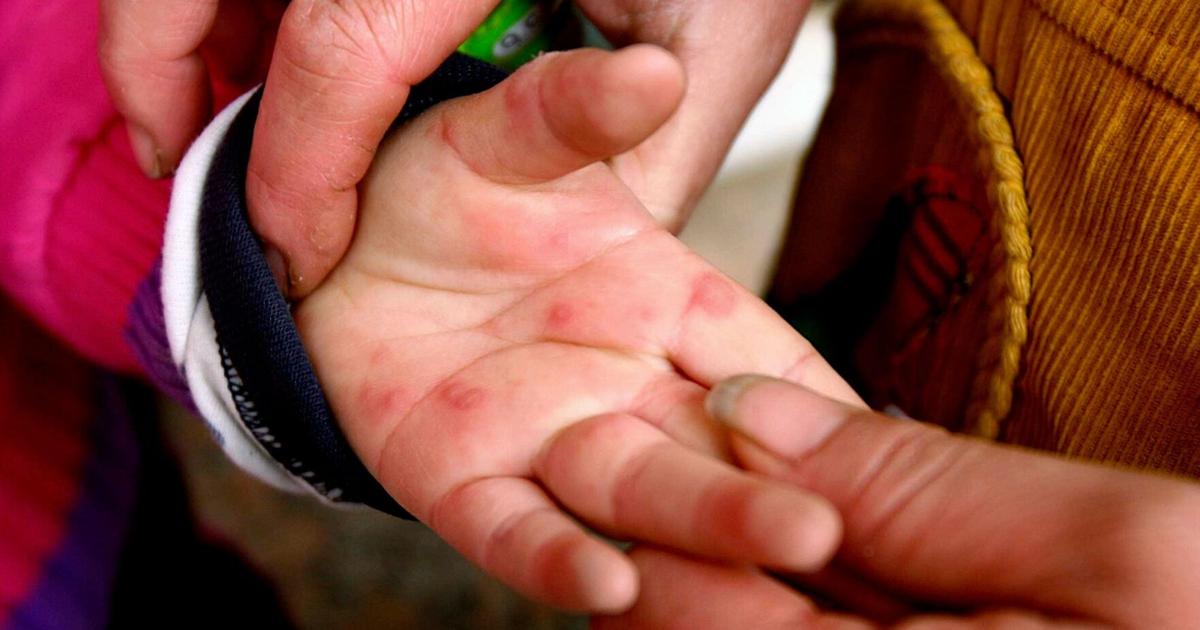**Rise in Hand, Foot and Mouth Disease Cases Reported in Mid-Atlantic Region**
Health officials in the mid-Atlantic region have recently reported a rise in hand, foot and mouth disease (HFMD). According to the District of Columbia Health Department, there were 197 emergency department visits related to the disease in September, primarily among children younger than 5. The Virginia Department of Health has also observed significant increases in emergency department and urgent care visits for HFMD. Compared to previous years, Virginia and West Virginia have seen a notable rise in reported outbreaks, with schools and day care centers accounting for the majority.
To better understand hand, foot and mouth disease — what it is, how it spreads, symptoms, and prevention — we spoke with CNN wellness expert Dr. Leana Wen. Dr. Wen is an emergency physician and clinical associate professor at George Washington University and previously served as Baltimore’s health commissioner.
—
### What is Hand, Foot and Mouth Disease?
**Dr. Leana Wen:**
Hand, foot and mouth disease is a highly contagious viral illness that primarily affects infants and young children. It is caused by a group of viruses known as enteroviruses, most commonly coxsackievirus A16.
It is important to note that HFMD is not the same as foot-and-mouth disease, which affects farm animals such as cattle, sheep, pigs, and goats and does not infect humans.
The disease gets its name from the small blister-like sores it causes on the hands, feet, and inside the mouth. While uncomfortable, HFMD is generally mild and resolves on its own.
—
### How is Hand, Foot and Mouth Disease Spread, and Who is Most at Risk?
**Dr. Wen:**
HFMD spreads very easily through close personal contact and contact with contaminated surfaces. Infection can occur through droplets released when a person coughs, sneezes, or talks.
The virus can also spread by touching an infected person — through hugging, kissing, or sharing cups and utensils. Additionally, the virus is present in stool, so changing diapers or bathroom assistance without thorough handwashing can lead to infection.
Contaminated objects and surfaces like toys or doorknobs can harbor the virus, which can then enter the body when a person touches their mouth, nose, or eyes. There is also rare transmission through swallowing contaminated recreational water, such as in pools not properly treated.
Young children are most vulnerable, mainly because their immune systems are still developing and they are more likely to have close contact with others and share toys.
—
### What Are the Symptoms, and How Long Do They Last?
**Dr. Wen:**
The first symptoms usually include a fever, sore throat, and a general feeling of being unwell. These flu-like symptoms start about three to five days after infection.
Within a day or two, painful small spots develop inside the mouth, often on the tongue, gums, or inner cheeks. These can turn into blisters or ulcers, causing discomfort while eating or drinking.
Around the same time, a rash may appear on the hands and feet, and sometimes on the buttocks, legs, or arms. This rash may manifest as flat red spots or small bumps that can blister but typically do not itch.
Some children may have mouth sores without the rash or the rash without mouth sores. Most cases are mild and resolve within about a week to 10 days.
During this period, keeping children well-hydrated is crucial since mouth pain may reduce their willingness to drink fluids.
—
### Can Adults Also Get Hand, Foot and Mouth Disease?
**Dr. Wen:**
Yes, adults can get HFMD, although it is much more common in young children. Most adults have some immunity from childhood exposure, but those without prior infection or with weakened immune systems can catch it through close contact.
When adults or teenagers contract HFMD, symptoms tend to be mild or even absent. Some may experience only a sore throat or mild rash without the typical mouth sores or blisters.
However, infected adults can still spread the virus to others, including young children.
—
### How is Hand, Foot and Mouth Disease Diagnosed and Treated?
**Dr. Wen:**
Healthcare providers usually diagnose HFMD based on characteristic symptoms and recent exposure to others who are sick. A physical exam is typically sufficient to confirm the diagnosis.
In rare cases where symptoms are severe or unusual, a clinician may take a throat swab or stool sample to test for the virus.
There is no specific medication to cure HFMD. Since it is caused by a virus, antibiotics are ineffective.
Treatment focuses on symptom relief. Over-the-counter pain relievers like acetaminophen or ibuprofen can help reduce fever and mouth pain. Cool, soft foods and cold drinks may ease eating and drinking discomfort.
Maintaining hydration is especially important as mouth sores can make swallowing painful, risking dehydration in young children.
Most cases resolve without complications. Parents should seek medical advice if a child cannot keep fluids down, has a high fever lasting more than a few days, or appears unusually drowsy or irritable.
—
### Should Parents Keep Children Home from School or Day Care?
**Dr. Wen:**
Because HFMD is usually mild, children do not need to stay home for the entire illness.
The Centers for Disease Control and Prevention (CDC) advises that children can return to school or day care once they are fever-free, feel well enough to participate in normal activities, and can manage mouth sores without excessive drooling.
Parents should check with their specific school or day care, as policies may vary.
In some cases, like during an outbreak, local health departments may recommend keeping affected children home temporarily to limit spread.
—
### How Can Families Help Prevent Infection?
**Dr. Wen:**
Yes, families can take several steps to reduce the risk of infection:
– **Practice regular and thorough handwashing.** Wash hands with soap and water for at least 20 seconds, especially after toilet use, diaper changes, before eating or preparing food, and after coughing or sneezing.
– **Cover coughs and sneezes.** Use disposable tissues or the elbow crook to contain droplets.
– **Clean and disinfect frequently touched surfaces and objects.**
– **Avoid close contact with infected individuals.** Don’t share drinks, utensils, toothbrushes, or towels, and minimize hugs or kisses when someone is ill.
By following these measures, families can help protect themselves and reduce the spread of HFMD.
—
For more information on hand, foot and mouth disease and updates on local outbreaks, consult your healthcare provider or visit the CDC website.
https://www.phillytrib.com/news/health/hand-foot-and-mouth-disease-is-on-the-rise-in-certain-areas-a-doctor-explains/article_47286796-ea11-4bd3-b051-f04ef62ea059.html



